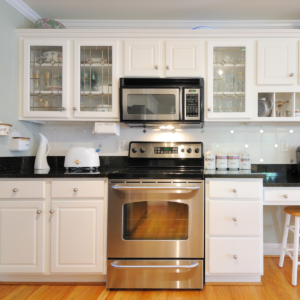
While many kitchen fires are caused by open flames, others are caused by kitchen appliances. Let’s take a look at the common appliances that cause fires, ways to prevent appliance fires, and kitchen fire statistics.
Top 5 Kitchen Appliances that Cause Fires
1. Ranges and Stoves
By far, ranges are the most common cause of kitchen fires. Electric ranges are at a greater risk than gas ranges to be the culprit of a kitchen fire. Grease fires can happen quickly on a cooktop and can get out of control quickly. During a grease fire, nearby items can catch fire if the grease splashes and spreads. Never pour water on a grease fire – this will only make things worse! In case of a grease fire, call 911 and use baking soda or kosher salt to extinguish the fire.
2. Dishwashers
If you’ve ever relied on the dishwasher heating cycle to dry your dishes, you know the amount of heat it can produce. The heating elements get wet, heat up, and cool down during each use. Although a dishwasher is not the most common appliance to cause a fire, a dishwasher is a fire risk when the internal heating elements malfunction or are not properly maintained. The most common reason a dishwasher causes a fire is when the moisture from the wash and rinse cycle comes into contact with the wires.
3. Refrigerators
Even though we associate cold temperatures with a refrigerator, they can cause fires. A fridge fire can occur in different ways including an overheated compressor, faulty electrical components, relay-switch short-circuiting, or even a lightbulb that stays on when the door is closed.
4. Microwaves
Although microwaves are generally safe appliances, fires are not uncommon in microwaves. The main source of microwave fires is accidental overheating of the food. An extra one or two minutes on a bag of popcorn will almost always result in a smoky, burnt mess. Frozen foods can also be a risk if you overestimate the amount of time to cook the meal. Another common cause of a microwave fire is just like other appliances – faulty wiring or an electrical short.
5. Toasters and Toaster Ovens
Just like microwaves, fires occur with toasters and toaster ovens when the food is overcooked and ignites. Other causes of toaster fires include flammable items such as dish towels too close to the appliance, as well as when the internal heating elements and lever springs malfunction.
Home Kitchen Fire Prevention Safety Tips
The best way to prevent a kitchen fire is prevention. Prevention starts with understanding how your appliances work, ways to safely prepare a meal, and what to do in case a fire occurs. Here are several fire prevention safety tips for both appliances and cooking:
- Never leave cooking unattended, even for a minute. Cooking fires can happen in the blink of an eye! Never walk away from a hot stove or another appliance that you are using for cooking. Keep your workspace clean and tidy and move all flammable items away from open flames.
- Do not set the dishwasher to run and leave the house. Many people start their dishwashers in the morning before leaving for work. What would happen if a fire started while you were away? Along the same lines, do not start your dishwasher right before bed. If your dishwasher catches fire while you are asleep, you may not discover it quickly enough to contain it.
- Practice home kitchen fire protection. Keep an operable fire extinguisher in your kitchen, just in case. Know how to use it in an emergency, and teach other members of your family how to use it. Sometimes accidents happen, and having a fire extinguisher nearby can be a lifesaver. Also, be sure your smoke alarms are working; change the batteries twice a year.
- Unplug unused appliances. Electrical shorts and malfunctioning appliances can cause fires. If you are not using your toaster, toaster oven, or other countertop appliance, unplug it. Inspect wires regularly to prevent electric fires.
Cooking and Appliance Fire Statistics
Cooking is likely a daily activity, or nearly a daily activity, for many homeowners. While we may not think twice about lighting the stove, heating the oven, or using an appliance, those activities do come with some risk. According to a recent study by the National Fire Protection Agency, cooking causes an average of 172,900 home structure fires per year. Of these fires, most are preventable.
Other findings from the report include:
- The most common cause of a kitchen fire was unattended cooking.
- Not surprisingly, cooking fires peak between 5:00 p.m.–8:00 p.m., prime dinnertime hours.
- The peak days for home cooking fires were Thanksgiving and Christmas.
- Deep fryers cause 5.4 deaths per 1,000 fires.
- Electric ranges are more than twice as likely to cause a kitchen fire than a gas stove.
- Microwave oven fires cost homeowners an average of $5,500 in damages.
- An average of 470 home cooking fires was reported per day in 2018.
Fire Damage Restoration Services
Even with proper prevention and kitchen safety, cooking and appliance fires can happen. While we hope you don’t need us, our emergency restoration team is here 24/7 to respond. Reynolds Restoration Services has been helping homeowners and businesses for more than 15 years restore their properties to their pre-loss condition after a fire.
Reynolds Restoration Services is the premier disaster restoration and reconstruction company in the Harrisburg, PA, Philadelphia, PA, New Jersey, Delaware, D.C., and Baltimore, Maryland service areas. Our qualified and dedicated staff can respond to fire, smoke, flood, storm, and mold damage quickly so you can get back into your home as soon as possible.

President of Reynolds Restoration Services. Over 20 years of experience in the emergency restoration industry.

